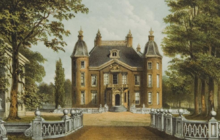Biljoen Castle
Biljoen Castle ( Dutch Kasteel Biljoen ) is a moated castle that was built around 1530. It stands between the Veluwe and the IJssel near the Dutch town of Velp in the municipality of Rheden .
The brick building with monument number 42145 is jointly managed by the “Foundation of the Friends of Gelderland Castles” (“ Dutch Stichting Vrienden der Geldersche Kasteelen ”) and the “Het Geldersch Landschap” foundation . It was built by Karl von Egmond , Duke of Geldern and Count of Zutphen , partly from building materials from the nearby Overhagen Castle.
Residents and building history
Due to financial difficulties, the Duke sold the castle with the associated rights on June 1, 1535 to his court master Roelof van Lennep (1500–1546), Drost von Middelaer. This left it to his son Carl van Lennep (1530–1567), Mayor of Arnhem , his grandson Roelof and his great grandson Johan. In 1633 Cunera van Lennep inherited the castle to Billion (1600–1657), initially married to her nephew Willem van Lennep and later to Willem van Broeckhuysen. After her death in 1657, her daughter Johanna van Lennep became the new owner. When she died childless four years later, after 126 years in the ownership of the van Lennep family, Biljoen was sold to Alexander von Spaen in 1661 .
He converted the central building into today's square building with four identical corner towers, all of which were provided with a baroque bell-shaped dome . At the entrance, the portal was broken out and replaced by a protruding middle section with a tympanum . Spaen expanded the castle estate in 1682 by merging with the Groot Beekhuizen estate. In 1672, the French King Louis XIV temporarily set up his headquarters in Biljoen, which is why - unlike many other castles - it was not burned down by the French army under the command of Henri de La Tour d'Auvergne . The French marshal was also Duke of Bouillon , which was undoubtedly another reason Biljoen was spared.
In 1692 Alexander Bernhard van Spaen became the new lord of the castle, but on his death in 1696 the castle property passed into the possession of his brother Frederik Willem, who finally settled in Biljoen after the forced sale of Till and Moyland Castle . The castle estate was expanded once more to include Overhagen, Nederhagen and Schloss Rosande . The next owner of Biljoen was Alexander Diederik van Spaen, mayor of Wageningen . His son Johan Frederik Willem (1746–1827) had the interior of the palace as well as its gardens and parks radically changed. The death of Alexander Jacobs van Spaen in 1848 marked the end of a period of 187 years of family ownership on Biljoen.
In 1848 the Baron van Hardenbroek (1807–1871) acquired the property. After 19 years he sold most of it to the German industrialist JH Willem Lüps. In 1872 he also bought the castle, so that the property was ultimately preserved undivided. For four generations it remained the property of the Lüps family, who kept it particularly well for the following 139 years, before the last male heir died in 2006. In 2008 the castle, including 162 hectares of land, was acquired by the "Het Geldersch Landschap" and "Friends of Gelderland Castles" foundations.
Interior
Six broad, arched steps made of bluestone lead to the entrance building in the neo-Renaissance style , which is crowned by a balcony . The design for this comes from the Arnhem architect Lucas Hermanus Eberson (1822–1889). The double-wing entrance door with two door knockers from bronze decorated in the form of lion heads.
The white entrance hall has a fourfold cornucopia (horn of plenty) on the ceiling and a dark blue stone floor. The walls are decorated with wreaths and garlands . A life-size nymph statue of marble greets visitors.
The Grand Ballroom is on the first floor . It's a fine example of neoclassical interior design.
Tapestries from the 17th century can be seen in several rooms of the castle . In the so-called gentleman's room , two different types of tapestries with animal motifs are put together. These are works from the Delft factory by Maximiliaan van der Gucht and Amsterdam tapestries by Alexander Baert. In the old dining room there are tapestries from Flanders , made around 1650 and signed by Simon Bouwens.
Also worth mentioning are the pompous Tante Thea salon from the beginning of the 20th century, which offers a view of the castle pond with island and park, as well as the old kitchen with oven and water pump.
Landscape park
The landscape between Velp and Rheden is largely determined by the land belonging to Biljoen with its waters and forests. The system extends along the Beekhuizen stream in a north-easterly direction as far as the dam area with its height differences.
The former formal garden in the French style from the beginning of the 18th century is documented on the so-called Hotting Map (1773–1783). Its paths still form a recognizable structure of the castle park. From 1784 onwards, the German landscape architect Johann Georg Michael (1737–1800) largely replaced the complex with a romantic landscape park that only respected and preserved some of the previously existing structures. The former canal was transformed into a lake with an island, so that the entire palace park could not be overlooked anywhere. This gave the impression of endlessness. Round flowerbeds were laid out in open areas, and curved paths were created using existing paths, which offered the visitor more and more new prospects. Between 1810 and 1822 the park was enlarged by Michael's son-in-law Jan David Zocher and given a uniform appearance.
Web links
Coordinates: 51 ° 59 ′ 48 ″ N , 5 ° 59 ′ 33 ″ E


